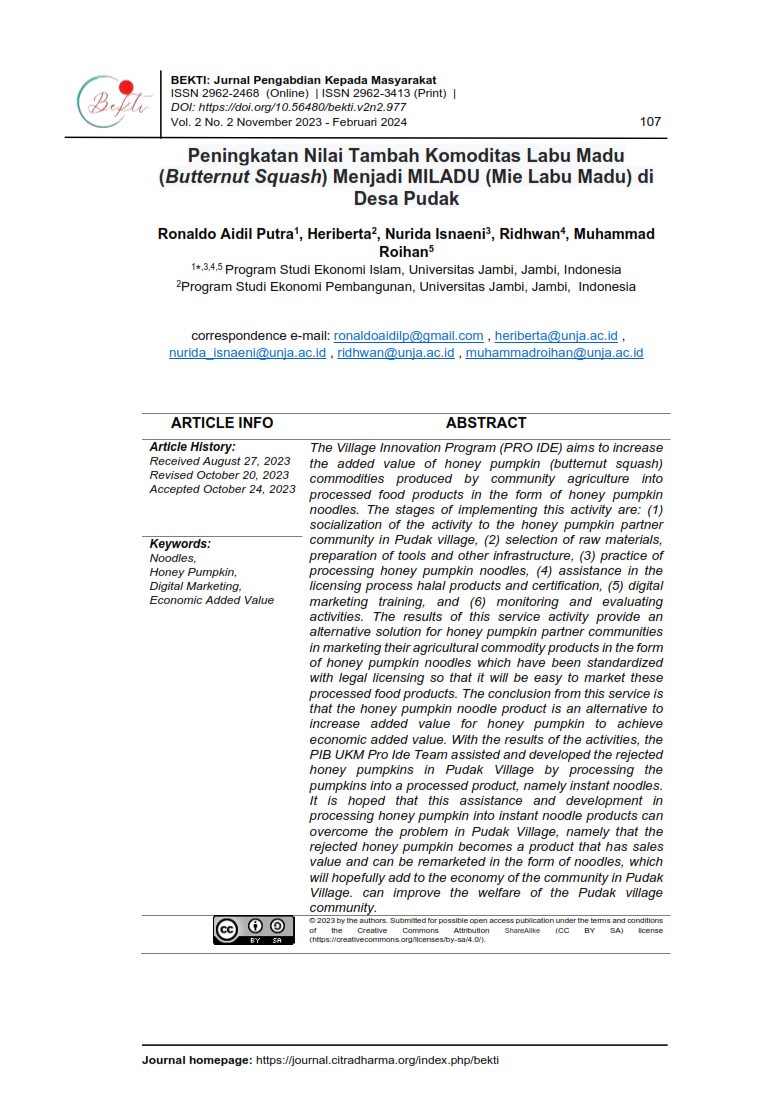Peningkatan Nilai Tambah Komoditas Labu Madu (Butternut Squash) Menjadi MILADU (Mie Labu Madu) di Desa Pudak
DOI:
https://doi.org/10.56480/bekti.v2i2.977Keywords:
Noodles, Honey Pumpkin, Digital Marketing, Economic Added ValueAbstract
The Village Innovation Program (PRO IDE) aims to increase the added value of honey pumpkin (butternut squash) commodities produced by community agriculture into processed food products in the form of honey pumpkin noodles. The stages of implementing this activity are: (1) socialization of the activity to the honey pumpkin partner community in Pudak village, (2) selection of raw materials, preparation of tools and other infrastructure, (3) practice of processing honey pumpkin noodles, (4) assistance in the licensing process halal products and certification, (5) digital marketing training, and (6) monitoring and evaluating activities. The results of this service activity provide an alternative solution for honey pumpkin partner communities in marketing their agricultural commodity products in the form of honey pumpkin noodles which have been standardized with legal licensing so that it will be easy to market these processed food products. The conclusion from this service is that the honey pumpkin noodle product is an alternative to increase added value for honey pumpkin to achieve economic added value. With the results of the activities, the PIB UKM Pro Ide Team assisted and developed the rejected honey pumpkins in Pudak Village by processing the pumpkins into a processed product, namely instant noodles. It is hoped that this assistance and development in processing honey pumpkin into instant noodle products can overcome the problem in Pudak Village, namely that the rejected honey pumpkin becomes a product that has sales value and can be remarketed in the form of noodles, which will hopefully add to the economy of the community in Pudak Village. can improve the welfare of the Pudak village community.
References
Adams, G.G., Imran, S, Wang, S., Mohammad, A, Kök, M.S, Gray, D.A, Channell, G.A,, Morris, G.A, & Harding. S.E. 2011. The hypoglycaemic effect of pumpkins as antidiabetic and functional medicines. Journal Foodres. (44):862- 867.doi:10.1016/j. foodres.2011.03.016.
Anonim. 2019. Cara Budidaya Labu Madu (Butternut pumpkin) di BPP Kecamatan Kalimanah.
Arianti, Mira. Erna Suminar. 2021. Teknologi Budidaya Labu Madu dan Pemanfaaatannya sebagai pangan alternative di Desa Pasigaran, Sumedang, Jawa Barat. Jurnal : Aplikasi Ipteks Untuk masyarakat. Volume 10 Nomor 2 halaman 159 -162.
Ashari. Muhammad Hasyim dan Firdaus Intania. 2022. Peningkatan Nilai Tambah Komoditas Labu Madu (butternut squash) Menjadi Kripik Labu Madu. Jurnal pengabdian kepada masyarakat. Volume 2 nomor 1 halaman 165 – 172.
Gaus, N., Ridwansyah, M., Hastuti, D., & Oktavia, A. (2024). Motivasi berwirausaha sebagai penentu keberhasilan perempuan dalam usaha mikro kecil dan menengah : Kasus Kota Jambi , Indonesia. 6(1), 1–19.
Musnaini, Ida Ketut Mudhita, Asrini. 2022. Pelatihan Budidaya dan Inovasi Produk Labu Madu Berbasis Hybrid Integratif Labu Madu Sebagai Potensi Manivestasi Ekonomi Kreatif Para Single Parent (Desa Binaan – SAPADU Kecamatan Kumpe Ulu – Jambi). Jurnal Pengabdian Masyarakat. Volume 5 Nomor 2 halaman 96 – 105.

Downloads
Published
Issue
Section
License
Copyright (c) 2023 Ronaldo Aidil Putra, Heriberta, Nurida Isnaeni, Ridhwan, Muhammad Roihan

This work is licensed under a Creative Commons Attribution-ShareAlike 4.0 International License.
Copyright Notice
Authors who publish with this journal agree to the following terms:
- Authors retain copyright and grant the journal right of first publication with the work simultaneously licensed under a Creative Commons Attribution-ShareAlike 4.0 International License that allows others to share the work with an acknowledgment of the work's authorship and initial publication in this journal.
- Authors are able to enter into separate, additional contractual arrangements for the non-exclusive distribution of the journal's published version of the work (e.g., post it to an institutional repository or publish it in a book), with an acknowledgment of its initial publication in this journal.
- Authors are permitted and encouraged to post their work online (e.g., in institutional repositories or on their website) prior to and during the submission process, as it can lead to productive exchanges, as well as earlier and greater citation of published work (See The Effect of Open Access).

This work is licensed under a Creative Commons Attribution-ShareAlike 4.0 International License.
Deprecated: json_decode(): Passing null to parameter #1 ($json) of type string is deprecated in /home/citra-dharma-journal/public_html/plugins/generic/citations/CitationsPlugin.inc.php on line 49











